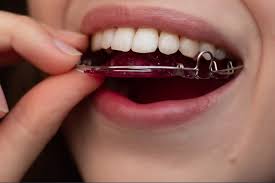Lip tie is when the upper lip can’t move freely because a tight band of tissue (the frenulum) connects it to the gum. Like tongue tie, but this time it’s the lip that gets affected. As a result, people may experience difficulties.
Lip-tie is often found in babies, especially those who have trouble breastfeeding, but it can last into adulthood if it isn’t treated. The frenulum on the upper lip may restrict lip movement, making it difficult to perform everyday tasks. However, the condition can be effectively treated, and seeking help early usually leads to a better outcome.
This in-depth guide will cover everything you need to know about lip tie, including its causes, how to identify it, how to treat it, and how to care for both babies and adults after treatment.
What Makes Lip Tie Happen?
When the frenulum, which is the thin band of tissue under the lip, is too tight, too short, or too thick, it can cause lip tie, which makes it hard for the upper lip to move. This can make it difficult for babies to eat and for older children and adults to speak or maintain good oral hygiene.
Genetic Factors
Genetics is the most common reason for lip tie. If a parent or close relative had a lip-tie, it’s more likely that the next generation will also have it. Specific factors that impact oral health, such as the size and shape of the frenulum, can be inherited from one generation to the next.
If one or both parents have a lip tie, their children might also have it. However, not everyone with a family history of lip-tie will develop it, and some cases may occur sporadically.
Development During Pregnancy
During fetal development, the frenulum usually doesn’t naturally separate from the upper lip and gum, which is when lip tie usually forms. In many cases, this connection remains tight, making it difficult for the upper lip to move after birth. This condition can make it hard for babies to breastfeed and use their mouths and tongues.
The development of the frenulum is significant for the growth of oral functions. A tight frenulum can happen if something goes wrong during pregnancy or fetal development, which can cause lip-tie. This condition can affect either side of the lip or both sides of the lip.
Signs and Symptoms of Lip Tie
The symptoms of lip tie can vary from person to person, depending on the severity of the condition and the individual’s age. In babies, lip-tie can make it hard to breastfeed. In older kids and adults, it can hurt their teeth, speech, and self-esteem.
-
Trouble latching on while breastfeeding
One of the most apparent signs of lip tie in babies is that they have trouble latching on when breastfeeding. The baby might not be able to make a good seal around the nipple, which would make breastfeeding painful for the mother and not enough for the baby. If a baby has a lip tie, they may also experience a weak suck, which can lead to difficulties gaining weight and experiencing hunger frequently.
The baby’s upper lip can’t flare out to make a proper latch, so the baby might gum or smack while feeding, which makes it hard for both the baby and the mother to breastfeed.
-
Gumming or Smacking While Eating
When babies have a lip tie, they often gum or smack their lips while breastfeeding or bottle-feeding. The upper lip can’t fully curl out to make a tight seal on the breast or bottle nipple, which is why this happens. This makes feeding less effective and can make both the baby and the mother angry.
-
Problems with the alignment of teeth in older kids
If you don’t treat lip tie, it can cause problems with how your teeth line up as you get older. A tight frenulum can impede the normal growth of teeth and gums. This can cause teeth to become out of alignment, develop gaps, or experience pain when they erupt. Children who don’t receive treatment for a lip tie may also experience difficulty maintaining oral hygiene, which can lead to gum disease or tooth decay.
In more serious cases, a lip tie can alter how the teeth come together, potentially requiring braces later in life.
-
Adults with Speech and Oral Motor Problems
A lip tie can make it difficult for adults to speak and perform tasks with their mouths. Because the upper lip can’t move as freely, people with a lip tie may have trouble with specific sounds, such as “b,” “p,” and “f.” People with a lip tie may also experience difficulty with activities such as kissing, whistling, or playing music.
Adults may also notice lip incompetence, which occurs when the lips fail to close completely when at rest. This can alter the appearance of your face and compromise your overall oral health.
How do doctors determine if someone has a lip tie?
In babies, diagnosing a lip tie is usually easy, but a more thorough examination may be necessary in older children and adults. This is how doctors usually figure out if someone has a lip tie:
-
Look at it
A doctor, such as a pediatrician or dentist, will examine the upper lip and frenulum to assess their condition. The provider will evaluate the tightness and elasticity of the frenulum to determine if it’s causing difficulty for the lip to move.
-
Breastfeeding Assessment for Infants
Lactation consultants or breastfeeding specialists can watch how a baby eats. If your baby has trouble latching on, sucks poorly, or hurts while breastfeeding, they may have a lip tie.
- Oral Health Assessment for Older Children and Adults (H3) A speech therapist, dentist, or orthodontist can assess how a lip tie might be affecting speech, oral motor function, and tooth alignment in older children and adults.
What to Do About Lip Tie
The good news is that there are effective ways to treat lip tie. The patient’s age, the severity of their condition, and the symptoms they are experiencing will all affect their treatment.
-
Frenectomy
The most common method of treating a lip tie is with a frenectomy. This procedure involves cutting or removing the tight frenulum, allowing the upper lip to move more freely. Several methods are available, including the use of a scalpel, laser, or electrocautery.
-
Laser Frenectomy
A laser frenectomy is a precise and minimally invasive procedure that uses a laser to cut the frenulum. This method usually causes less bleeding, heals faster, and lowers the risk of infection.
- Scalpel Frenectomy: Sometimes, a scalpel frenectomy is done, which means cutting the frenulum with a clean scalpel. This way is more traditional, but it works.
-
Treatment for babies lip tie that doesn’t involve surgery
In mild cases, especially if the baby is experiencing only minor difficulties with eating, non-surgical treatments such as working with a lactation consultant may be recommended. These methods help with latch and feeding without the need for a frenectomy.
Aftercare and Recovery
After a frenectomy or other treatment for a lip-tie, it’s essential to take proper care of yourself to ensure a smooth healing process and prevent potential problems. Here are some critical things to do after:
-
Aftercare for Babies
After the procedure, babies may experience some discomfort or slight swelling around the treated area. The mother should keep breastfeeding because it calms the baby and helps them heal. The pediatrician may suggest gentle stretches to ensure the lip can move freely.
-
Aftercare for Kids and Adults
Adults and older children may require speech therapy or oral exercises to enhance their oral motor skills. They should avoid foods or activities that could worsen the treated area, such as acidic foods or rough rubbing of the lip.
-
Managing Pain and Swelling
After treatment, both babies and adults may have mild swelling and pain. Ice packs and over-the-counter pain relievers can help with any pain you have while you heal.
When Should You Get Help for Lip Tie?
If you or your child has symptoms of lip tie, like trouble breastfeeding or trouble speaking or teeth that aren’t lined up right, you should see a doctor right away. Early intervention can prevent problems from worsening and improve outcomes, especially when it comes to feeding babies and helping older children and adults learn how to use their mouths effectively.
Final thoughts: How to Understand and Treat Lip Tie
Lip tie is a common issue that can affect people of all ages. A lip tie can make it hard to eat, talk, and take care of your teeth, but treatments like a frenectomy can help and offer numerous benefits. Seeking professional help is the first step toward improving oral function and overall health if you or your child is experiencing difficulties with a lip-tie.
Consult with a pediatrician, dentist, or speech therapist to discuss your treatment options and determine the one that best suits your needs. A lip tie can be effectively managed with the proper care, which can improve feeding, speech, and overall oral health.





